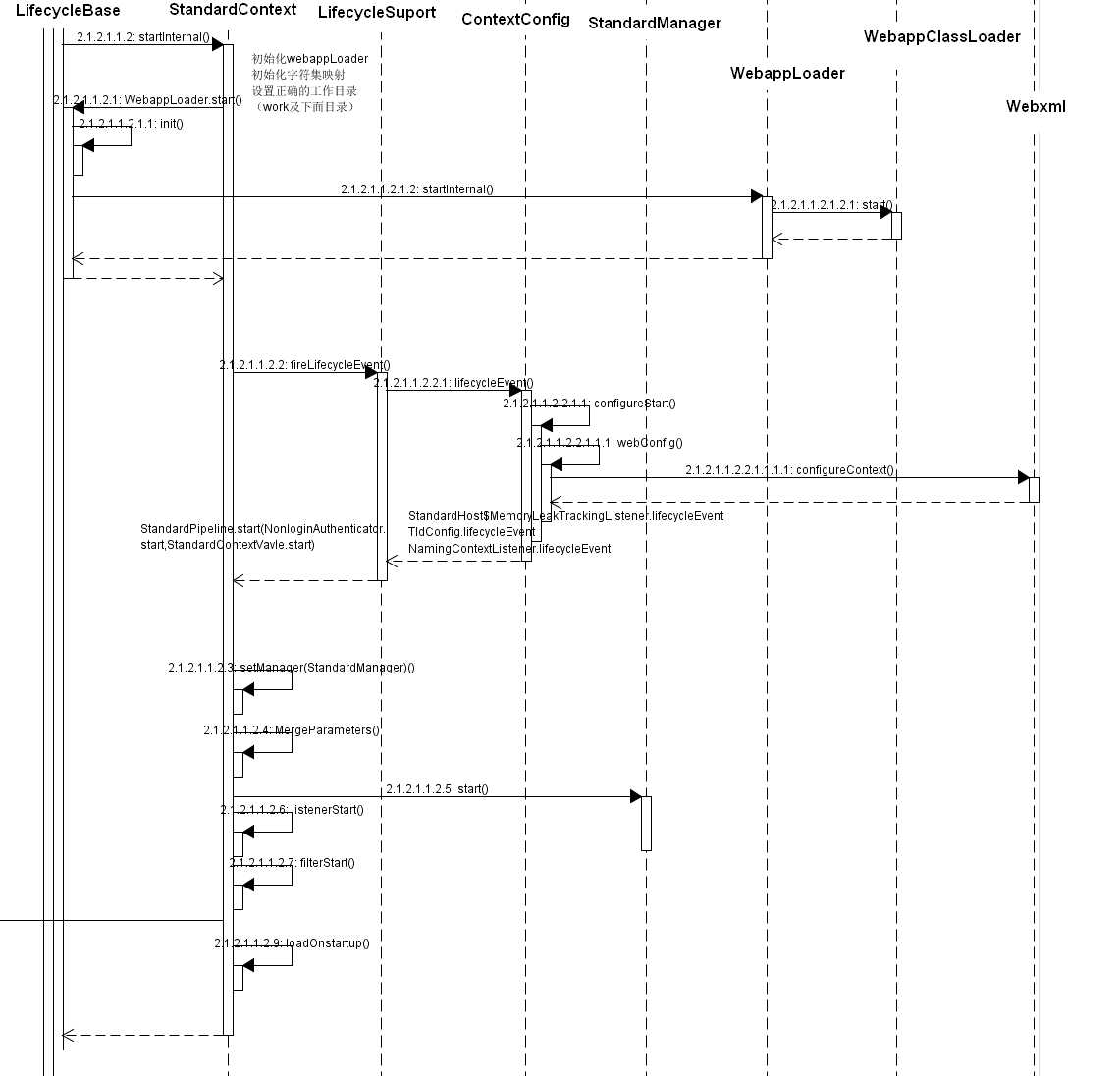标签:
上一节说到StandardService负责启动其子组件:container和connector,不过注意,是有先后顺序的,先启动container,再启动connector,这一节先来看看container。
在第二节(How Tomcat works — 二、tomcat启动(1))中没有介绍关于Pipeline和Vavle,因为前面侧重的是整个架构,但是在初始化的时候就不得不说了。
Pipeline,就是一根管道,用来连接两个容器,在一个容器流向下一个容器的时候使用。在tomcat中也是这个意思,很形象,Engine、Host等都是容器,在执行完上一个容器(比如Engine)的相关操作的时候要开始执行下一个容器(比如Host)的操作了,这个时候需要经过一根管道pipeline,那么我们可以在管道中执行一个其他必要的操作,这个时候可以在管道上面添加Vavle(阀),一根管道pipeline上可以有多个阀门(也很形象)。每根管道都有一个默认的阀门。
在tomcat实现中有一个实现了Pipeline接口的类StandardPipeline——是每两个容器之间的管道,每个容器都有一个默认的Valve实现StandardEnginevavle、StandardHostValve、StandardContextVavle、StandardWrapperVavle。
其实valve的作用和filter的作用类似。
StandardEngine作为整个容器的最顶层负责启动其子组件——StandardHost,对,他就这一个作用。
这个方法被超类LifecycleBase.init方法调用,主要作用就是调用超类LifecycleMBeanBase.initInternal方法注册MBean,并初始化一个startStopExecutor(ThreadPoolExecutor),后面用来使用线程启动子容器。
这个方法的主要作用就是调用父类的方法Container.startInternal——主要的操作就在这个方法里面:

protected synchronized void startInternal() throws LifecycleException { // Start our subordinate components, if any if ((loader != null) && (loader instanceof Lifecycle)) ((Lifecycle) loader).start(); logger = null; getLogger(); if ((manager != null) && (manager instanceof Lifecycle)) ((Lifecycle) manager).start(); if ((cluster != null) && (cluster instanceof Lifecycle)) ((Lifecycle) cluster).start(); Realm realm = getRealmInternal(); if ((realm != null) && (realm instanceof Lifecycle)) ((Lifecycle) realm).start(); if ((resources != null) && (resources instanceof Lifecycle)) ((Lifecycle) resources).start(); // Start our child containers, if any Container children[] = findChildren(); List<Future<Void>> results = new ArrayList<Future<Void>>(); for (int i = 0; i < children.length; i++) { results.add(startStopExecutor.submit(new StartChild(children[i]))); } boolean fail = false; for (Future<Void> result : results) { try { result.get(); } catch (Exception e) { log.error(sm.getString("containerBase.threadedStartFailed"), e); fail = true; } } if (fail) { throw new LifecycleException( sm.getString("containerBase.threadedStartFailed")); } // Start the Valves in our pipeline (including the basic), if any if (pipeline instanceof Lifecycle) ((Lifecycle) pipeline).start(); setState(LifecycleState.STARTING); // Start our thread threadStart(); }
StandardHost的作用和StandardEngine类似,都是初始化启动子容器,不过这里是StandardContext。启动的方式也一样,所以就不再详述。
这个类才是重中之重,解析web.xml、部署webapp都在这儿实现。在StandardHost中调用StandardContext.start方法,执行的是超类LifecycleBase.start方法,主要进行了如下操作

在该方法中主要进行了MBean的注册,再就是触发了Lifecycle.AFTER_INITEVENT事件,ContextConfig是StandardContext的listener,在发生该事件的时候执行ContextConfig.init方法,在该方法中主要是构造一个能解析web.xml的digester。
由于LifecycleBase没有实现该方法,所以就是直接调用StandardContext.startInternal,在StandardContext.startInternal方法中主要进行了如下操作:

container部分终于启动完成了,不过还是有些部分略过了,比如StandardWrapper(这个还可以往深挖,不过也包含在StandardContext的启动过程中)初始化和webapp的发布。到现在发现,这些启动过程就是围绕生命周期的这几个方法展开:
How Tomcat works — 四、tomcat启动(3)
标签:
原文地址:http://www.cnblogs.com/sunshine-2015/p/5746920.html